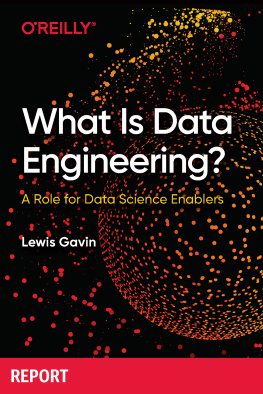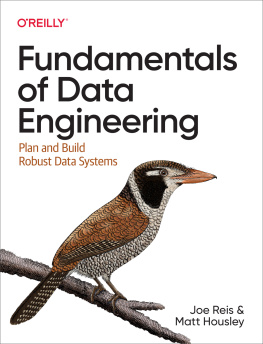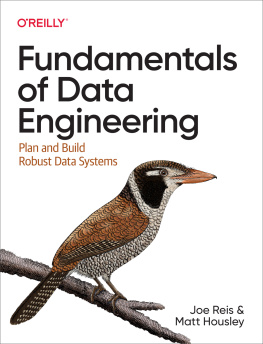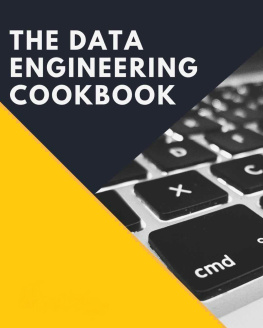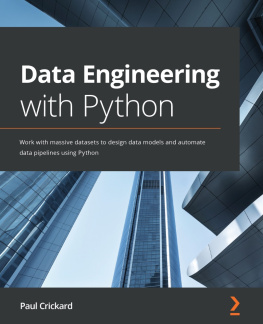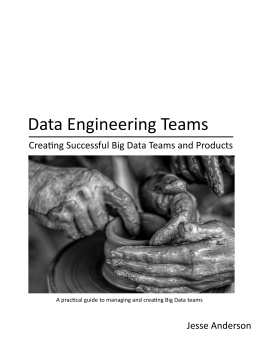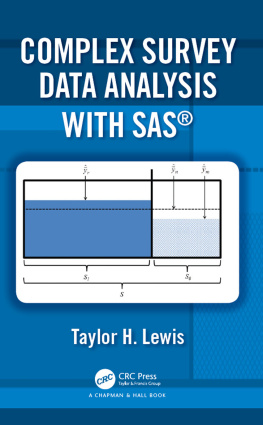Lewis Gavin - What Is Data Engineering?
Here you can read online Lewis Gavin - What Is Data Engineering? full text of the book (entire story) in english for free. Download pdf and epub, get meaning, cover and reviews about this ebook. year: 2019, publisher: OReilly Media, Inc., genre: Politics. Description of the work, (preface) as well as reviews are available. Best literature library LitArk.com created for fans of good reading and offers a wide selection of genres:
Romance novel
Science fiction
Adventure
Detective
Science
History
Home and family
Prose
Art
Politics
Computer
Non-fiction
Religion
Business
Children
Humor
Choose a favorite category and find really read worthwhile books. Enjoy immersion in the world of imagination, feel the emotions of the characters or learn something new for yourself, make an fascinating discovery.
- Book:What Is Data Engineering?
- Author:
- Publisher:OReilly Media, Inc.
- Genre:
- Year:2019
- Rating:3 / 5
- Favourites:Add to favourites
- Your mark:
- 60
- 1
- 2
- 3
- 4
- 5
What Is Data Engineering?: summary, description and annotation
We offer to read an annotation, description, summary or preface (depends on what the author of the book "What Is Data Engineering?" wrote himself). If you haven't found the necessary information about the book — write in the comments, we will try to find it.
What Is Data Engineering? — read online for free the complete book (whole text) full work
Below is the text of the book, divided by pages. System saving the place of the last page read, allows you to conveniently read the book "What Is Data Engineering?" online for free, without having to search again every time where you left off. Put a bookmark, and you can go to the page where you finished reading at any time.
Font size:
Interval:
Bookmark:
by Lewis Gavin
Copyright 2020 OReilly Media, Inc. All rights reserved.
Printed in the United States of America.
Published by OReilly Media, Inc. , 1005 Gravenstein Highway North, Sebastopol, CA 95472.
OReilly books may be purchased for educational, business, or sales promotional use. Online editions are also available for most titles (http://oreilly.com). For more information, contact our corporate/institutional sales department: 800-998-9938 or corporate@oreilly.com .
- Acquisitions Editor: Jessica Haberman
- Development Editor: Amelia Blevins
- Production Editor: Christopher Faucher
- Copyeditor: Gary Gorski
- Proofreader: Christina Edwards
- Interior Designer: David Futato
- Cover Designer: Karen Montgomery
- Illustrator: Jenny Bergman
- December 2019: First Edition
- 2019-12-04: First Release
The OReilly logo is a registered trademark of OReilly Media, Inc. What Is Data Engineering?, the cover image, and related trade dress are trademarks of OReilly Media, Inc.
The views expressed in this work are those of the author, and do not represent the publishers views. While the publisher and the author have used good faith efforts to ensure that the information and instructions contained in this work are accurate, the publisher and the author disclaim all responsibility for errors or omissions, including without limitation responsibility for damages resulting from the use of or reliance on this work. Use of the information and instructions contained in this work is at your own risk. If any code samples or other technology this work contains or describes is subject to open source licenses or the intellectual property rights of others, it is your responsibility to ensure that your use thereof complies with such licenses and/or rights.
978-1-492-07556-1
[LSI]
Data has increasingly become more popular and is the backbone to many of the modern platforms available today such as Google search, Facebook, Amazon, Spotify, Uber, Tesla, AirBnB, and many more. Its the reason why companies like Google and Facebook are some of the largest in the world. The explosive growth of some of these companies and their ability to transform whole industries, such as the music industry (Spotify) or the taxi industry (Uber), is due to their use of data.
Much of this growth is attributable to the work carried out by data engineers and data scientists. It is common to hear in the mainstream media about data science and the field of machine learning; however, the field of data engineering is just as important and plays a vital role within modern businesses.
Now this isnt a report about the battle of data engineers versus data scientists. Instead, this report will delve into the key aspects of data engineering: why its an important field based on what it enables and how, together with data science, it provides the backbone to the latest tech in the industry.
Data engineering is becoming more and more popular but is actually a role that has existed for quite some time. Data engineers have been branded in a whole host of different ways in the past, including as database administrators (DBAs), data analysts, business intelligence engineers, database developers, and more.
Recently, although the core role itself has remained fairly constant, the term data engineering has taken on slightly different connotations due to several changes in the market. But at its heart, data engineering is all about the movement, manipulation, and management of data.
This trend has snowballed from the large businesses mentioned in the first paragraph to many others as they come to understand the importance and power of data and not in the traditional sense of just storing basic application and customer data, but storing every event in as little detail as possible. The more data you have, the more knowledge you can redeem from it. You can see in that the global datasphere grew to 40 zettabytes (ZB) in 2019 (1 ZB is around a billion terabytes) and will continue to grow as more businesses harvest its power. This growth in data production has led to major advancements in data technology and data jobs, especially in the fields of data engineering and data science.
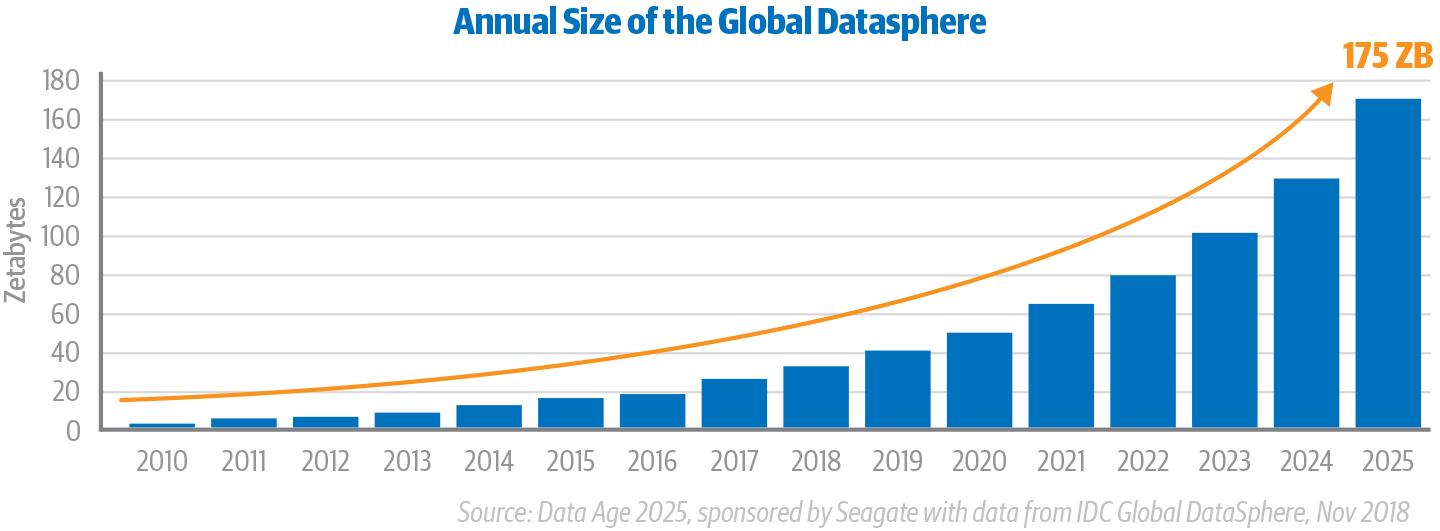
The existing technologies and previously used infrastructure werent suited to store this new wave of event data, as the volume became very large, very quickly. This meant that not only would systems eventually slow down but the existing payment models surrounding them meant businesses would have to pay very large amounts of money to support them.
The emergence of big data technologies is where data engineering picked up its modern definition. The term big data came into use as early as 1998. John Mashey used it to define the growth in data storage and data production. In 2001 Doug Laney produced a report for Gartner that took this definition one step further and wrapped it up into the three vees: volume, velocity, and variety.
To deal with the three vees, data warehouses became data lakes and technologies such as Hadoop were developed to help store and process this data on commodity hardware. It seemed like a no brainer for businesses to adopt big data solutions due to the promise of easily scalable storage capacity and faster processing at a much smaller price.
This gave birth to the modern data engineer, a hybrid of a data engineer and a software engineer. Eventually, the marketplace caught up, and Facebook created a technology called Hive for Hadoop that allows SQL to be used. Businesses could then migrate existing skill sets over. Businesses like Facebook and LinkedIn continued to push the boundaries to make the development of big data solutions easier.
However, the differences between the traditional data engineer and a software engineer have become ever smaller as the integration of data capture and data processing has become embedded into core parts of services, instead of just the business information (BI) that sits around them. Finding efficient ways to capture data in real time, process it, generate user-bespoke content, and store it has lead to huge growth in the number of engineers that understand both software and data, and it is now the rule rather than the exception that data engineers have these skill sets.
To leverage all this new data, businesses also needed new methods of processing data. Machine learning and artificial intelligence (AI) became popular very quickly due to the availability of data sets that are large enough to build useful models. Data science is the emerging field for these techniques and is often seen as the money maker over data engineering; however, when the two roles coexist, they complement each other.
Data scientists require data from many sources that need manipulation and aggregation before being used. This is where the marriage with data engineering comes into play, as there is a large amount of engineering required to build an accurate machine learning model. Add on the difficulty of dealing with extra large data sets and these data manipulation tasks quickly become tedious for data scientists, who naturally prefer to (and should) spend their time on increasing the accuracy of their models.
This marriage with data science might explain why data engineering is currently one of the most , Google Trends also shows that interest in the search term data engineer is on the rise and is currently at its all-time highest.
Font size:
Interval:
Bookmark:
Similar books «What Is Data Engineering?»
Look at similar books to What Is Data Engineering?. We have selected literature similar in name and meaning in the hope of providing readers with more options to find new, interesting, not yet read works.
Discussion, reviews of the book What Is Data Engineering? and just readers' own opinions. Leave your comments, write what you think about the work, its meaning or the main characters. Specify what exactly you liked and what you didn't like, and why you think so.

